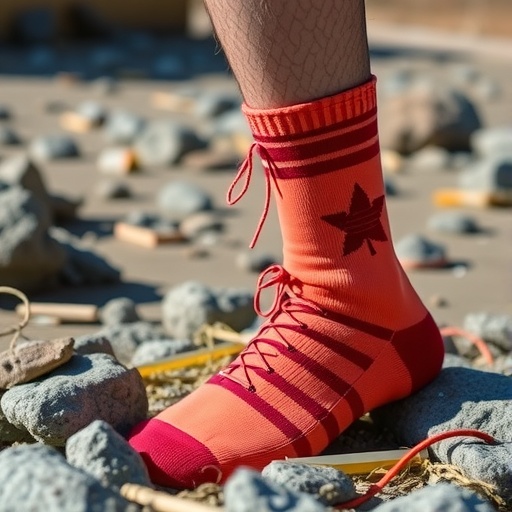New Breakthrough in Blackfly Trapping Signals an End to ‘Human Bait’ Practice in River Blindness Surveillance
In a groundbreaking development that promises to revolutionize the fight against river blindness, researchers from an international coalition led by Sightsavers have demonstrated a safer and equally effective alternative to the ethically contentious practice of using humans as live bait to capture blackflies. This advancement, showcased at the 2025 American Society of Tropical Medicine and Hygiene (ASTMH) conference, could profoundly alter vector surveillance and disease control strategies across Africa, where millions remain at risk of onchocerciasis.
For decades, the primary technique endorsed by the World Health Organization to monitor blackfly populations—the vectors responsible for transmitting Onchocerca volvulus, the parasitic worm causing river blindness—relied on the ‘human landing catch’ method. This method involves volunteers exposing their skin to attract and capture biting blackflies, a task fraught with risk and discomfort. Despite precautionary measures and prophylactic treatments, the method not only exposes volunteers to blackfly bites but also to other harmful vectors such as mosquitoes and tsetse flies, creating significant ethical and health concerns.
The multinational research initiative, spanning Ghana, Côte d’Ivoire, Malawi, and Mozambique, explored sixteen permutations of novel insect traps, termed Esperanza window traps, designed to lure blackflies effectively without human presence. These traps integrate carbon dioxide emission to simulate human breath—a key attractant for blackflies—with sensory cues like color variability, trap orientation, and olfactory lures, including worn socks and synthetic ‘stinky foot’ scents, mimicking the natural odors blackflies pursue when seeking hosts.
Laboratory and field evaluations revealed that seven pairs of these strategically placed traps could capture blackflies with efficiency matching that of one human flycatcher, a significant breakthrough in entomological surveillance. Notably, regions characterized by higher blackfly densities, such as Ghana and Malawi, exhibited excellent trap performance using yeast-generated carbon dioxide combined with worn socks, a cost-effective and readily accessible solution. Conversely, in locales with sparser fly populations like Côte d’Ivoire and Mozambique, this hybrid of yeast-derived CO₂ and human scent odorants surpassed trap configurations employing synthetic CO₂.
“While volunteers have altruistically risked their health to aid disease surveillance, ethical dimensions of exposing humans to infectious vector bites have long demanded alternative solutions,” stated Dr. Louise Hamill, co-lead researcher and Sightsavers’ Director for Onchocerciasis. “The simple addition of used socks—a humble but powerful attractant—has enabled us to create a trap on par with human bait, demonstrating the potential for ethical and sustainable vector monitoring.”
The implications of this advancement extend beyond ethical improvements. Traps deployed in high densities near breeding sites simultaneously act as control measures by disproportionately capturing female blackflies seeking blood meals necessary for egg development. This dual action could substantially reduce vector populations over time, offering long-term protective benefits to afflicted communities, an effect analogous to integrated vector management seen in other parasitic disease control programs.
River blindness, predominantly prevalent in 29 African nations, affects at least 250 million individuals. It is caused by the filarial nematode Onchocerca volvulus, which can reside in the human host for upwards of 15 years, producing microfilariae that migrate to skin and ocular tissues. The resultant intense itching, dermatitis, and chronic inflammation often culminate in irreversible blindness, making this parasitic disease a major contributor to disability and socioeconomic deprivation in endemic areas.
Beyond the debilitating symptoms, the social ramifications are profound. The conspicuous skin lesions and visual impairments contribute to stigmatization and social exclusion, undermining educational opportunities and economic productivity. Furthermore, there is growing evidence linking early-life infection with onchocerciasis-associated epilepsy, complicating the disease’s public health burden.
Despite the absence of vaccines or prophylactic measures, mass administration of ivermectin effectively kills microfilariae and interrupts transmission cycles when coverage is sufficiently high. The recent achievement by Niger, becoming the first African country certified by the WHO to have eliminated river blindness, underscores the feasibility and importance of sustained control efforts. However, reliable and ethical vector surveillance remains critical to identifying residual transmission and ensuring eradication.
The development of non-human bait trapping technologies aligns with this goal, allowing continuous, less hazardous monitoring of blackfly populations. The scientific rigor applied in evaluating various trap designs across distinct ecological regions attests to the adaptable and pragmatic approach taken by the researchers, offering scalable solutions that local health ministries can integrate with existing public health infrastructure.
While the Esperanza window traps require only minimal maintenance and simple setup, their environmental and logistical advantages over human landing catches are considerable. By mitigating human exposure and empowering communities with safer tools, this innovation stands to enhance both the ethical landscape and operational efficiency of onchocerciasis control programs.
Dr. Hamill further notes, “In high-transmission settings, the ability to reduce the vector population through trap deployment could transform local disease epidemiology. This strategy provides a dual benefit, revolutionizing how we understand and interrupt the transmission cycle of river blindness.”
As river blindness remains a formidable parasitic disease, advancements such as these illuminate the intersection of ethical research practices and disease control innovation. The collaborative effort by Sightsavers, GLIDE, and national ministries exemplifies the international commitment required to defeat neglected tropical diseases, progressing toward a world where such diseases no longer threaten health or livelihoods.
Subject of Research:
The development and evaluation of alternative blackfly trapping methods to replace human landing catches in river blindness surveillance.
Article Title:
Ending the Human Bait Era: Innovative Trapping Technologies Offer Ethical Breakthrough in River Blindness Control
News Publication Date:
Embargoed to 13 November 2025
Web References:
Sightsavers: https://www.sightsavers.org
Global Institute for Disease Elimination (GLIDE): https://glideae.org
American Society of Tropical Medicine and Hygiene (ASTMH): https://www.astmh.org/annual-meeting
Image Credits:
Louise Hamill / Sightsavers
Keywords:
River blindness, onchocerciasis, blackfly trapping, vector control, infectious diseases, parasitic diseases, neglected tropical diseases, entomological surveillance, public health, ethical research, disease elimination




